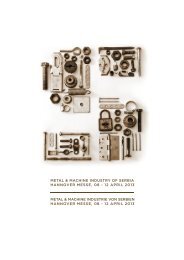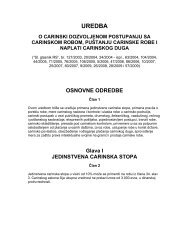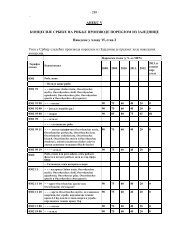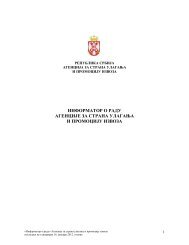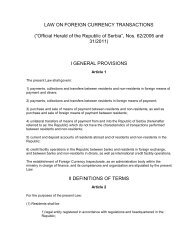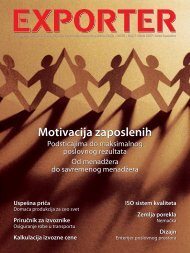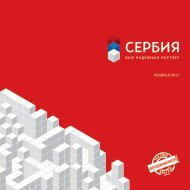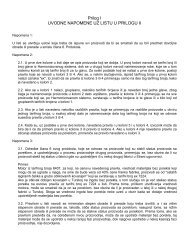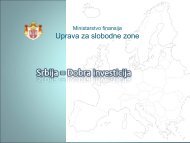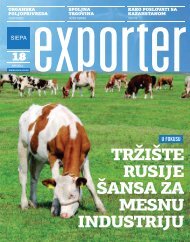Serbia Shared Services - Siepa
Serbia Shared Services - Siepa
Serbia Shared Services - Siepa
- No tags were found...
Create successful ePaper yourself
Turn your PDF publications into a flip-book with our unique Google optimized e-Paper software.
About <strong>Serbia</strong><strong>Serbia</strong> ID CardOfficial NameForm of StatePolitical StructureRepublic of <strong>Serbia</strong>Democratic RepublicPresidentUnicameral assembly with 250 seatsArea 88,361 km 2Population9.5 millionGeographic PositionSouth East Europe, central part of the Balkan Peninsula, at the intersection ofPan European Corridors N 0 . 10 and N 0 . 7BorderIn the east–<strong>Serbia</strong> borders Bulgaria, in the northeast–Romania, in the north–Hungary, in the west–Croatia and Bosnia-Herzegovina, in the southwest–Montenegro, and in the south–Albania and MacedoniaClimateTemperate continental, with monthly average temperatures ranging between0.7°C in January and 17.5°C in JulyOfficial Language <strong>Serbia</strong>nMain ReligionChristian OrthodoxOther Religions Roman Catholic, Islamic, Jewish, ProtestantMajor Cities Belgrade: 1,576,000; Novi Sad: 298,000; Nis: 250,000CurrencyDinar (RSD)GDP (2010)€29,343 millionGDP pc (2010) €4,016Time Zone Central European Time (GMT + 01:00)Internet Domain .rs3
Labor PoolUnemployment Rate (%)Labor PoolThe labor market in <strong>Serbia</strong> has become truly vibrant with an increasing number ofinternational investors relocating their businesses to the country. When it comes tothe shared service industry the market is still fresh, as only a handful of internationalcompanies have capitalized on the opportunities that beckon. Recruitment ofyoung graduates and undergraduates is simple given the high unemployment rate,especially among the under-30 population. Many are keen to work for internationalcompanies. Work ethics are good, while shared services centers are not viewed asa transition industry, but a career for young people. The demographics are right: ayoung, ambitious, educated population, in a country where employment rates aresuch that demand has kept wage expectations at competitive levels.<strong>Shared</strong> services centers would be regarded locally as an employer of choice, bothby bright school-leavers and graduates looking for immediate opportunities with longtermprospects. The motivation to attract and retain good staff is, after all, one of thekey drivers for the centres’ existence, as its allows HR issues to be handled muchmore quickly and efficiently than before – an imperative which has increased with thetravelling habits of both staff and partners.AvailableOfficial dataUnemployment remains one of the key economic issues in the country. The state isparticularly interested in curbing high unemployment rates among young populationand introduces more and more benefits for employers that provide employment forthis category of the population.The rate in Belgrade is lower than in other parts of the country (12.85%), butgiven that almost 1/4 of the total <strong>Serbia</strong>n population reside in the capital city theactual number of the unemployed and available for employment is quite high.The Participation in the Registered Unemployment by the Age25-29 years 30-34 years 35-39 years 40-44 years 45-49 years 50-54 years13.29% 12.46% 12.03% 11.63% 11.85% 11.79%Source: <strong>Serbia</strong>n National Employment ServiceThe Structure of the Unemployed by the Level of Education in December 2010Elementary School High-school College University244,218 396,350 44,128 44,78733.47% 54.33% 6.05% 6.14%Source: <strong>Serbia</strong>n National Employment Service13.3September 2009 March 2010 September 2010 March 2011Source: Statistical Office of the Republic of <strong>Serbia</strong>19.2 19.2Inside the NutshellThe labor market in <strong>Serbia</strong> is officiallyrepresented through a state governedinstitution National Employment Serviceof <strong>Serbia</strong>. This institution has developed anetwork of branches throughout the countrywith 34 rep offices and 120 local offices.They are registering unemployed, undertakingstate programs of employment, education,additional education, mediating betweenemployers and the unemployed and runningofficial statistics on the labor market.However, there are also privately ownedcompanies that offer more immediate andquality access to the available labor pool. Oneof the most prominent and highly regardedis the mojtim.infostud.com Internet portal.It is a unique source of job opportunitiesfor the unemployed but a great tool foremployers to swiftly access the pool ofpeople looking for a job, whether theyare unemployed or just seeking for a jobchange. This particular service relieson the database of people that havedecided to submit their CVs into thesystem. Currently, the database consists of31,245 CVs/candidates (as of June 2011).22.267
Labor PoolBy definition these people are proactive, eager to work and computer literate.SIEPA team has a good cooperation with Infostud management which enablesa variety of options – from test selection process, probation, interviews withcandidates etc.The following survey was conducted based on the screening of the available data.Distribution of Applicants by age (%)over 55 0.6646-55 5.1541-45 4.7636-40 8.0031-35 16.7026-30 35.4618-25 29.03up to 18 0.34The largest number of job candidates fall into the 18-35 age category, with thelargest sub-group made up of people aged 26-30 - around 35% of respondents -whilst the 18-25 category is also strongly represented, as they account for 30%share in the overall number of people which have visited the website and decidedto register as job seekers.More than a third of thecandidates have a universitydegree, while the distributionby gender is more-less even.Almost all candidates in thedatabase have some computerskills, out of which close to40% of them boast advancedskills such as being able todo programming and softwaredevelopment, web design andnetwork engineering.Distribution by the Level of Education (%)Ph. D. 0.30Master degree 2.53University 37.76College 16.42Highschool 46.86Elementary school 1.13The survey among youngsters in Belgrade* has shown the same level offlexibility - the young and unemployed in Belgrade prefer jobs that match theireducational level, but majority of them are willing to work outside their profile.Almost 40% are willing to work on jobs with lower demands for education.Local AttritionGlobally, every fourth person in the world is ready to move out of the countrylooking for a better job. For the same reason, every fourth person is planning toleave his or her current employer within the next 12 months.The GfK International Employee Engagement Survey was conducted using a sampleof 30,556 employees from 29 countries from February 8 th to April 4 th , 2011 usingonline communication and telephone interviews. The data was adjusted in order torepresent demographic composition of the country (industry, gender and age). Also,each country’s data was adjusted according to its GDP in order to assure globalstatistics combining different countries.Source: SIEPA Source: SIEPA In <strong>Serbia</strong>, the percentage of employees actively seeking a job changeis 28%, which is lower than that of most other countries surveyed inDistribution by the Work ExperienceOver 10 years5-10years2-5 yearsSource: GfK18%16%24% 21%21%No workexperienceup to 2 yearsDistribution by Their Willingness to RelocateYes,anyplaceNoSource: GfKthe region. In combination with high unemployment rates, this leads toexpected low attrition rates.27%25%7%4%Yes, just aroundmy place ofresidence28%9%Yes, onlyin certaincitiesEmployees Acitively Looking for Job Change (%)Hungary 31Russia 35UK 38Slovakia 27US 47Czech R. 27Germany 41Romania 40Bulgaria 37<strong>Serbia</strong> 28Source: GfKLabor PoolMobilityOne of the interesting characteristics of the labor force in <strong>Serbia</strong> is its mobility, bothin terms of willingness to relocate and to work outside of profession and educationallevel. Around 45% of candidates in Infostud’s database are based in the Belgradearea and the rest of the unemployed are mostly willing to relocate to another city ifthe potential position satisfies other conditions desired by job-seekers.*Ipsos Strategic Marketing for Youth Office, City of Belgrade, May 2010, DESK research, Data from theNational Employment Service and interviews, 800 youngsters from Belgrade,random sample on the 19-30y of age group8 9
Labor PoolEducatedOn average, universities in <strong>Serbia</strong> annually produce around 43,500 college anduniversity graduates. High-quality education is chiefly a result of primary andsecondary schools offering more advanced curricula in natural and social sciencesthan the majority of other countries. For example, students from Belgrade’sMathematical Gymnasium alone have won more than 100 prizes at World ScienceOlympiads. The most recent success was the achievement of a six-member team ofmathematicians from <strong>Serbia</strong> winning one gold, two silver and one bronze medal anda commendation at the 52 nd International Mathematics Olympics in the Netherlandsin 2011. A total of 105 countries participated in that Olympics.In order to further enhance the quality of teaching provided, domestic universitieshave implemented substantial reforms in line with international standards. Moreflexible and diversified curricula, along with hands-on training and new textbooks,are aimed at equipping students with the fundamental problem-solving skills requiredin the business world.The country’s key institution at the university level for the in-depth study of foreignlanguages is the Faculty of Philology at the University of Belgrade. However, thereare also faculties in other major cities where students can study foreign languages.Languages are taught at a very high level and are studied together with the respectivecountries’ cultures.The Actual Number of People in Infostud's DatabaseLanguage English French Italian German SpanishLevel Inter. Adv. Inter. Adv. Inter. Adv. Inter. Adv. Inter. Adv.Electrical Engineering 1,460 770 27 7 18 8 24 3 9 3Informatics 450 287 10 2 9 5 16 3 8 2Mechanical Engineering 317 177 7 1 5 3 12 0 3 0Philology 588 486 70 34 74 40 60 27 95 47Economics/Management 2,782 1,509 126 19 132 34 161 43 137 27Law 495 257 26 9 13 6 29 8 25 2Total 7,036 4,285 470 80 452 158 406 101 386 122Total - people residing in Belgrade, with high-school+level of educationIntermediate - Level B2Advanced - Level C1+, spoken languageLabor PoolTotal Number of Enrolled Students 2009/2010: 54,510 (Selected universities)School ofEconomicsPhilology SchoolLaw SchoolFaculty ofOrganizationalSciences*MechanicalEngineeringICT and ElectricalEngineering1,483 1,380 1,527 732 583 828* Management and software developmentSource: Statistical Office of the Republic of <strong>Serbia</strong>Total Number of Graduates* (2009, ): 42,988ICT Electronics EngineeringManagement/businessLawPhilology2,397 644 1,556 12,681 2,900 1,355* College graduates, university undergraduates, graduates and postgraduatesSource: Statistical Office of the Republic of <strong>Serbia</strong>Knowledgeable in Foreign LanguagesEnglish, French, Russian and German languages are mandatory subjects throughoutprimary and secondary education in <strong>Serbia</strong>. English usually begins to be taught fromthird grade as the primary language, whilst French, German and Russian are taughtfrom fifth grade as secondary languages.Foreign languages – usually English, French and German– are also mandatorymodules at colleges and universities, with a special focus on vocabulary used in thespecific scientific areas being taught.10 11
Labor PoolCompetitively PricedAverage salaries in <strong>Serbia</strong> are low enough to ensure cost-effective operation. Totalcosts for employers are only 40% of those in other East European EU member-states.Income tax and national insurance contributions are still among the lowest inCentral and Eastern Europe. Total labor costs for employers stand at 63% of net salary.Real salaries fluctuate in the few percent range ensuring the cost competitiveness of<strong>Serbia</strong>’s labor force.Example of Gross Salaries in EUR, Comparative AnalysisCountry/Position Accountant Chief AccountantTelemarketingOperatorCall CenterOperatorSlovakia 808 n/a 587 840Czech Republic 887 1,110 636 882Hungary 730 1,460 475 751<strong>Serbia</strong> 492 691 365 545Bosnia and Herz. 670 927 591 n/aSource: Infostud; exchange rate September 2011, 1 EUR = 102 RSDLabor PoolAverage Net Salaries (%)Average Net Salaries in EUR4%3%2%1%-0%-1%IINominal Gross SalaryIII IV I II III IV I2009 2010 2011Source: National Bank of <strong>Serbia</strong>IISlovenia 987.0Croatia 755.0Hungary 518.0Montenegro 484.0Bosnia & Herzegovina 418.0Macedonia 367.0Romania 358.5<strong>Serbia</strong> 357.0Bulgaria 352.0Average Ourly Labour Cost (€)<strong>Serbia</strong>BulgariaRomaniaLithuaniaLatviaPolandHungarySlovakiaCroatiaCzech R.PortugalSloveniaGreeceUKGermany0 5 10 15 20 25 30Source: Commerzbank Corporates & Markets, EurostatSource: Eurostat, March 201114 15
Labor PoolTaxation of SalariesIn <strong>Serbia</strong>, total costs of labor – i.e. the amount paid by the employer – include netsalary, income tax,and contributions paid by the employee and employer.Income tax does not apply to the following: public transport allowance (to andfrom one’s place of work), meal allowances on business trips in <strong>Serbia</strong> and dailyallowances on business trips abroad, accommodation and transport allowances, aswell as solidarity relief in the event of sickness.A €400 Net Salary ExampleItem Rate Total (EUR)Net salary 400.00Personal Income Tax 12 48.00Contributions paid by employee 17.9 71.60Gross salary 519.60Contributions paid by employer 17.9 71.60Total labor costs 591.2Enticing IncentivesWhen deciding on outsourcing certain activities abroad and implementing the sharedservices concept, companies base their initial decisions on a myriad of factors–notleast, near-shore and offshore locations, corporate taxation, property costs, salaries,language capabilities, and saturation of local recruitment markets. And, just in caseany lingering doubts remain as to where to invest your money,the Government hasintroduced further incentives to make sure you choose <strong>Serbia</strong> as your next outsourcinglocation.Financial IncentivesState grants are offered for Greenfield and Brownfield projects carried out bycompanies involved in the internationally marketable service sector.Investment in the internationally marketable service sector:• Available funds: from €2,000 to €10,000 per every new employee;• Minimum required investment: €500,000;• Minimum number of new jobs created: 10.Labor PoolSource: SIEPABased on the exchange rate: EUR 1= RSD 81Staff Leasing ConceptThe majority of international HR, recruitment, and head-hunting agencies havealready set up their operations in <strong>Serbia</strong>. Besides conventional HR services, manyoffer staff leasing services*. This service – contracting a service provider– allowscompanies to have greater control over recruitment costs, time-to-hire, and qualityof hire. This approach gives companies flexibility, cost savings, and an increasedcandidate pipeline to ensure they get the best staff on the market when required.Some of the major global players operating in <strong>Serbia</strong> are Adecco, Manpower, Dekra,Hill International, Trenkwalder etc.Another advantage of this approach is that firms can hire these temporaryemployees via the recruitment provider, thereby reducing payroll and administrationcosts even further. HR departments can focus on the human capital side of thebusiness, and target business objectives, dispensing with the administrative burdens ofmultilingual recruitment. By outsourcing these processes it no longer pays fees-per-hire,substituting a monthly fee for all the company’s recruitment needs.The National Employment Service GrantsThe National Employment Service grants include:• Employment subsidies program (grants €850–1,700);• Apprentice program(grants €170–210), and• Re-training program (€850).Incentives for employing certain categories of populationAs part of the employment support strategy, the National Employment Serviceoffers an attractive incentive package for potential employers. The forms of financialassistance available range from subsidies for job creation in under-developed regionsand for certain categories of the population, through to sharing retraining costs.The complete list of incentives provided can be downloaded from SIEPA’s website (www.siepa.gov.rs).*For more information and a full list of service providers, please contact SIEPA experts.16 17
Telecommunications Network: An Open SpeedwayMarket overviewTelecomm Market OverviewAccording to the Agency for Electronic Communications telecomm market in <strong>Serbia</strong>nominally grew by 6.4% in 2010 to $2.12 billion. The market comprising fixed andmobile phone services, media content distribution, Internet services and VOIP hadaverage annual growth of 13.9% in the four preceding years.Expansion and furtherliberalization of the industry is a priority for the Government as it seeks to beginmembership talks with the European Union. The competition on the market is evergrowing and will be even more in favor of users after the sale of the largest telecommservice provider in <strong>Serbia</strong> - Telekom Srbija.Internet AccessBroadband Internet access is widely available in <strong>Serbia</strong>. ISPs offer a variety ofbroadband internet access options at speeds of up to 16 Mbps on the retail market.Best sellers are those at 1024 kbps, 1536 kbps 2048 kbps speed which accountfor 57% of all broadband connections. Due to the increased competition among ISPsand ever rising needs of end users, the prices of internet access are decreasing overtime. For example, in 2009 the price of monthly fee for cable internet access at thespeed of 2 Mbps was around €14, the same amount for twice faster access in 2010.Telecommunicationsnetwork: An Open SpeedwayNumber of ISPs by Access Type2007 2008 2009 2010Dial-up 60 48 36 42Cabl Internet 14 22 20 22Optical Cable - - 3 11Ethernet - - 24 25Wirless Internet 118 82 78 115ADSL 23 21 27 23Source: RATELTotal Number of ISPs2007 2008 2009 2010Number of ISPs 159 197 199 192Source: RATEL1819
Where to Set Up?Belgrade20“When it comes to hospitality, there are no words to describe it.How canI describe that generosity? Actually, we feel like at home. It has been ourpleasure to come and work here”.Mirko Bernuzzi, Director, Pompea <strong>Serbia</strong>Booming business, mixed with vibrantculture and everyday life in <strong>Serbia</strong> offersinspiration to all those willing to experiencewhat is truly a jewel in the European crown.The thriving real estate scene throughoutthe country offering first class business andresidential premises, health care provided inboth state and private institutions, favorablepersonal taxation, and excellent internationalschools make <strong>Serbia</strong> the ideal choice for expats.Due to the specific needs of the SSindustry, at this point, <strong>Serbia</strong>'s capital andNovi Sad emerge as natural choices for newprojects. In the near future, other big cities in<strong>Serbia</strong> would also increase their capacity tohost SS projects.The capital city:the economic, university, political and cultural hub of <strong>Serbia</strong>.Southern Europe’s City of the Future for 2006-2008, as chosen by FDiMagazine(Financial Times), and among the most developed cities in theregion based on economic potential, cost efficiency, human resources, IT andtelecommunications, transport, quality of life, and FDI promotion.Belgrade has always been shaped by its history – situated at the historiccrossroads of Eastern and Western empires, each has left its mark as newgenerations continue to build and fight over this highly-prized metropolis. Tounravel Belgrade’s mystery and charm, one must contemplate this history, whileat the same time, enjoying and reveling in the city’s passionate demeanour.Whether it is the bustling city centre, or the trendy riverbank cafés perchedalong the Danube and Sava rivers, the city’s joie de vivre is omnipresent, andoffers something for visitors of all tastes,the whole year round. An eclectic mixof architecture sees the latest trends seamlesslyincorporated side-by-side with Belgrade’s classicheritage, as a city that has always pioneeredchange in the field continues to blossom. Just asit never ceases to surprise its many inhabitants,Belgrade will amaze and astonish its visitors as itgoes through yet another rebirth.“I have lived in Belgrade for 4 years and Imust say, personally, I believe that Belgradeis the most attractive and most interestingcity in Europe. There is no doubt”.DoerteWeidigFormer President of ProCredit Bank, <strong>Serbia</strong>“I remember when I first came to Belgrade,I could feel the energy of the city. It isunbelievable, everything is moving, thecountry is very open-minded, and most ofthe country caters toall your needs”.Oliver MallerChief Technology Officer, Baufinanzierung - Bayern21Where to Set Up?
Where to Set Up?Belgrade UniversityThe University of Belgrade is the oldest and the most important higher educationinstitution in <strong>Serbia</strong>. It is also one of the largest universities in the Balkan region, withover 78,000 students and 2,500 members of teaching staff.The University has 31 faculties, 8 scientific research institutes, and a systemof university libraries and information centers. The following types and levels ofstudies are realized at the University of Belgrade: undergraduate academic studies,undergraduate professional studies, graduate academic studies, specializedacademic studies, specialized professional studies, doctoral academic studies andmultidisciplinary studies.Studies conducted at the faculties of the University areadapted to the principles of the Bologna Declaration.Teachers and associates of the University of Belgrade make the largest part ofthe entire scientific potential of <strong>Serbia</strong>.The faculties and academic departments areclustered into five groups according to their academic characteristics, and include:faculties for bio-technical sciences, social sciences, medical sciences, naturalsciences and mathematics, and technical sciences.Undergraduate students have achoice of around 150 basic educational curricula, while around 1,700 postgraduatestudents can hone their knowledge in a range of specialized courses.www.bg.ac.rsLiving in Belgrade / <strong>Serbia</strong>Council of Europe awards Belgrade the title of “the 12 stars city”The Council of Europe (COE) awarded Belgrade the title of “the 12 stars city,” whichconfirms that the <strong>Serbia</strong>n capital is devoted to respecting the principles of theEuropean charter on local self-government. In October 2010, the European weekof local democracy (EWLD) was held in Belgrade for the first time ever. The ELDWis an annual European event featuring national and local events organized byparticipating local authorities in all COE member States.Belgrade - City of the Future in Southern EuropeThis title carries a recommendation for the biggest future investment location,by the most recognized financial newspaper in the world The Financial Times,organizer of the European cities and regions of the future for 2006/07 contest.Categories and criteria by which the judges have made their decision arebased on economic potential, cost effectiveness, human resources, IT andtelecommunications, transport, quality of life and FDI promotion.“Belgrade has many such secret delights it keeps close to its chest, making everyvisit a voyage of discovery even for those who may have been many times before.Stand aside Amsterdam, Prague and Barcelona – this is Europe’s new capital ofcool, with not only 42 museums, 67 art galleries and 26 theatres but a vibrant cafésociety and lively nightlife, It’s a history packed but thoroughly modern city forthe young and the young at heart”.Where to Set Up?“Berlin, Amsterdam, Barcelona - where next?If you’re into clubbing holidays and have done the usual suspects, <strong>Serbia</strong>’s capitalBelgrade has come on to the radar quickly in recent years, developing an exciting, everchangingcobweb of clubs and bars. Belgrade is different enough to enjoy daytimearound the city before hitting the town for an evening of revelry”.Belfast Telegraph, May 2011“Life is very cosmopolitan, it is very easy to integrate, and I have a great quality of life.It’s relatively easy for me to get back to the UK at weekends, as my children do not livehere with me. But when they come over to visit, my kids love it. They stay forever. Theydon’t want to go back when they come”.Anthony Burnett, Plant Manager, Ball Packaging22 23
Where to Set Up?Belgrade’s Office Space MarketThe vast majority of office stock in Belgrade is located in two areas: the traditional coreof Old Belgrade, referred to as “downtown” and New Belgrade across The River Sava.The majority of establishments in the Old Belgrade are C Class office buildings with afew A and BClass office buildings refurbished and improved in the last couple of years.In contrast to hilly, Old Belgrade, the area of New Belgrade is completely flat and set outon a US-style grid pattern, with numbered “blocks”. The majority of new office space islocated in New Belgrade, due to the ease of locating and purchasing development land,transparency of ownership, modern facilities and infrastructure, and the availabilityofparking space. Class B offices dominate the office stock in New Belgrade.still offering more flexible incentive packages in contract negotiations (whether in terms ofrent-free period, fit-out contribution or better parking ratio). A large portion of class A officespace was leased for €12-14 per sqm, while class B achieved €9-11 per sqm.CEE Prime Office Rents in 2010Prime Rent (€/sq.m/month)Sofia 14.0Prague 21.0Budapest 20.0Warsaw 25.0Where to Set Up?AvailabilityDespite the construction slowdown experienced by the Belgrade office market during2010, the total stock of Class A and B office space increased by 76,100 Sqm. By theyear-end it stood at 658,419 Sqm. Of this, Class A stock comprises 414,503 SqmGLA which is an increase of 22.5% compared to 2009. The total stock of Class Bspace remained the same level – 243,916 Sqm.Bucharest 19.5Belgrade 14.5Bratislava 17.0Zagreb 16.0Source: Commerzbank Corporates & Markets, EurostatVacancyThe vacancy rate increased to 26,8% by the end of H1 2011, which equates to177,500 Sqm. Class A vacancy increased compared to the previous year, driven inlarge part by additions to stock, while Class B vacancy decreased. By type, therewas 120,000 Sqm of vacant Class A – a vacancy rate of 28%. Class B vacant spaceaccount for 57,000 Sqm – a vacancy rate of 23%.OutlookOver 50,000 Sqm of space was on track to be delivered to the market in 2011. Thiscomprises of primarily Class A stock, delivered by a few key developments.(Source for Real Estate data: Colliers International, King Sturge, CB Rechard Ellis)Costs of livingVacant Space in Belgrade140,000120,000100,00080,00060,00040,00020,000SqmQ1 2008Source: Colliers InternationalClass AClass BOver allQ2 2008 Q1 2009 Q2 2009 Q1 2010 Q2 2010RentsAlthough rents for all types of office space experienced a decrease, there was a greater fallin Class A rents, due to the higher level of new additions. Prime headline rents by yearendfell to €16 per Sqm. In general, headline rents for Class A space vary from €13 to€16 Sqm/pcm. Class B rents remained steady at ca. €13.5 Sqm/pcm. The landlords areAccording to the Eurostat*, costs of living and operating in <strong>Serbia</strong> are among the lowestin Europe. For instance, the prices of electricity, gas, and other fuels, as well as costs ofpostal services, landline telephony, fax service and maintenance of motor vehicles arethe lowest among 37 European countries. In terms of the prices of consumer goods,<strong>Serbia</strong> stands at 52% of the European average with only Albania and Bulgaria beingcheaper. Prices of clothes and footwear are near European average (98 and 95%,respectively) while food and beverages price indexes are closer to those in Bulgaria.Costs of telecomm services are at the very bottom of the list, by far lower than in almostall European countries – 39%, while most of the assessed countries standing at 60%.Prices of restaurants and hotels are almost as double as low as the European average(54%), leaving Romania, Albania and Macedonia at the bottom of that list. <strong>Serbia</strong>is inexpensive the most when it comes to electricity, gas and other fuels, telecommservices and car maintenance. Prices of cloth and consumer electronics are almostat the average level for Europe. Index for food and beverages is 65%, alike Bulgaria(66%), but more than Macedonia with 51%.*Costs-of-Living Indices 2011, Eurostat; Countries included – EU27, Iceland, Norway, Switzerland andcandidate countries – Turkey, Bosnia, Albania, Croatia, <strong>Serbia</strong> and Macedonia.24 25
Where to Set Up?Novi SadThe second largest city in <strong>Serbia</strong> and the administrativecentre of the Province of Vojvodina.A city that inspiresgreat pride among its inhabitants, and with goodreason. Often compared to Belgrade, it has a similarcharm, culture, and night-life to the capital, but on asmaller, more personal scale. For those who appreciateart, music, food and fun, but prefer an easy-going citywithout the frenetic hustle and bustle of Belgrade (whichhas been called the city that sleeps less than New York!),Novi Sad is a perfect mix of urban sophistication andbohemianlaissez faire.Located on the plains of northern Vojvodina, the cityis also known as “a haven of tranquillity and tolerance”for being one of the <strong>Serbia</strong>’s most multi-ethnic cities.Besides beautiful scenery, Novi Sad offers a myriad ofrestaurants featuring unique Vojvodina cuisine that drawson the influences of <strong>Serbia</strong>n, Hungarian, Romanian, andSlovakian spices and traditions.The University of Novi Sad was established in 1960.Today, it boasts 13 faculties located in four of theAutonomous Province of Vojvodina’s largest cities andtowns: Novi Sad, Subotica, Zrenjanin, and Sombor. Itemploys 2,700 teaching personnel, and has 38,000students.The University is the second largest (of six) stateuniversity in <strong>Serbia</strong>, and is held in high esteem atEuropean level, recognised for its reformist orientation.The main University campus, catering to all a student’seducational and leisure needs, is situated in one of themost unique and beautiful settings in the region.“All the people that I‘ve been in touch with since I first came to <strong>Serbia</strong>have been always very friendly and hospitable. They are always up for ajoke; they like making the most of life and are never too busy not to beable to have a drink and friendly chat with you”.Mr. Fabio Corsi, Country Manager ICEWhere to Set Up?26 27
Success StoriesEuronetEuronet is a US venture and a global leader in processing secure electronic financialand payment transactions, employing 3,400 people in 31 countries. In 2010,the Company processed approximately $56 billion in ATM, prepaid and moneytransfer payments for more than 115 financial institutions, 200 mobile operators,approximately 385,000 retailer and agent locations, and millions of individualconsumers worldwide.This huge customer base is served through company’sCustomer Support Centre in Belgrade and its sister center in the US.Euronet entered the <strong>Serbia</strong>n market in 2002 with the distribution and maintenanceof ATMs, and the company also launched the use of VISA and Master Card systemsin <strong>Serbia</strong>. It was the first US investment in <strong>Serbia</strong> after the start of the reforms in thecountry. Customer Support Centre was opened in 2004 to take advantage of the timezone difference between the US and Europe, as well as of the outstanding languageskills of the local workforce. It now employs over 70 multilingual operators.While Euronet’s decision to invest was initially market-driven, the company selected<strong>Serbia</strong> over other countries in the region for the following reasons: <strong>Serbia</strong> offersEurope´s lowest corporate profit tax rate (10%), duty free access to many markets andavailability of large,highly skilled workforce.To successfully operate a global CustomerSupport Centre, a location providing multilingual staff is a must – Belgrade, with itsextensive pool of highly-educated, multilingual graduates, was the natural choice.The <strong>Serbia</strong>n market has proven to be highly lucrative – the introduction ofVISA and Master Card systems, the launch of the national DINA card system, anddevelopment of an ATM network throughout <strong>Serbia</strong> made the local Euronet branchone of the most profitable business units in the whole group. Moreover, the <strong>Serbia</strong>nmarket demonstrated a huge potential for further business expansion – the companyexpects 20% annual revenue growth over the next five years.Customer Support Centre staff have demonstrated not only excellent skills andprofessionalism but also exceptionally high company loyalty, with the staff retentionrate well above the industry average.Euronet plans to further expand its core business and introduce an additional100+ new ATMs throughout <strong>Serbia</strong> over the next 2 years.In addition to its existing operation, the company also intends to expand itsportfolio of services by launching a software development centre exporting softwaresolutions to other markets. Euronet’s operation in <strong>Serbia</strong> should, therefore, soonreach 100 employees, including highly specialised software programmers.www.euronetworldwide.netSitelSitel is a world leader in outsourced customer care services. With over 26 yearsof industry experience, Sitel has twice been ranked as the top overall call centeroutsourcing provider in Datamonitor’s annual Black Book of Outsourcing survey.Sitel’s 52,000 employees provide clients with predictable and measurable Returnon their Customer Investment by building customer loyalty, increasing sales andimproving efficiency. Sitel’s solutions span 135+ domestic, nearshore, and offshorecenters in 26 countries across North America, South America, Europe, Africa,and Asia Pacific. The company is privately held and majority owned by Canadiandiversified company, Onex CorporationTo solidify it’s near shore offerings the company expanded operations into Belgrade.Awell educated workforce, high national literacy levels and lower costs meant anattractive proposition for Sitel. “With such a large untapped Balkans talent pool, <strong>Serbia</strong>is the perfect choice for our latest location. Potential contact center candidates therenot only have high standards of education, but also close cultural affinity with our NorthAmerican and European customers,” says Tim Schuh, general manager, Northern EMEA,Sitel. “They have access to those same consumer products, use the same computer andsocial media tools as those who they’re assisting from overseas. And the wide breadthof languages we can support from Belgrade, which includes English, German, Italian,French and Russian, make it a highly attractive solution for our clients.”Sitel considered several other locations globally, but was impressed by <strong>Serbia</strong>and specifically, Belgrade as a regional business center. An educated, multilingualworkforce combined with available local talent and first class call center infrastructuremade Belgrade the obvious choice.“<strong>Serbia</strong> has many qualities which are similar to our successful sites in Bulgariaand Poland. Sitel is constantly evaluating markets across the world to ensure weleverage available labor pools and infrastructures to provide our clients with the bestpossible service and Return on Customer Investment,” continues Schuh.Sitel has market leading operations with numerous customer care contact facilitiesacross Europe and the globe. Sitel provides services to many of the biggest andbest known brands in the world, and is now well placed to accept new clients intoBelgrade as it moves forward with projected plans for a state-of-the-art customercare contact center in the <strong>Serbia</strong>n capital.Sitel’s contact center will start off with 300 employees in September 2011 andgradually increase the number of people to possible 2,200. The value of investmentis €1.25 million and the state has subsidized the project with €750,000.www.sitel.com.2829
Success StoriesTrizmaTrizma was founded in 2002 as the first Contact Centre Service Provider in <strong>Serbia</strong>.Since then we have served a portfolio of domestic and international clients for theirvarious business needs.We believe that <strong>Serbia</strong> today is an attractive near-shoring destination forinternational companies seeking to optimize their cost base by relocating parts oftheir operations to a more competitive market. With this in mind, we have focusedon providing added-value services for a wide range of companies - banks, telecoms,insurance companies, retail chains, utilities, private businesses and governmentalinstitutions, that are either present in <strong>Serbia</strong> or are looking to set operations here.Through our long standing partnership with CSC, a leading global provider ofbusiness solutions and services, we are proud to be serving the embassies or severalGovernments in countries such as <strong>Serbia</strong>, Montenegro, Bosnia-Herzegovina, Macedonia,Russia, Ukraine and Kazakhstan for visa issuing and related needs. Today, as well as inthe past, we have worked with companies such as Microsoft, Beiersdofr (Nivea), Nestle,Carlsberg, Telenor, BancaIntesa, EFG Eurobank, Metro, UNICEF, British AmericanTobacco, IMP, HP, Maxi, Imlek, Coca Cola, and many others who have trusted Trizmato handle various types of phone, email and web-based contacts with their customers.Trizma services are grouped in 3 broad areas:• Operational,• Online and• Managed <strong>Services</strong>.Our Operational <strong>Services</strong> assume outsourcing of various Business Processessuch asgeneral customer management, information and complaint lines, phonecollections, telemarketing and telesales, market research and various levels oftechnical support services.Our Online <strong>Services</strong> cover web portal design and development including integrationof leading-edge solutions for digital archiving, digital vaults and certificated documentexchange provided with our partners - French group STS.Managed <strong>Services</strong> are offered on a Build, Operate and Transfer model whichbrings our foreign partners a risk-free, fast-start model for local market entry.We are passionate about Operational Excellence. This means delivering value to ourClients by day-to-day monitoring of operational results and seeking constant processimprovement, while conforming to highest technical and security standards in the industry.www.trizma.com3031
T +381 11 3398 550F +381 11 3398 814office@siepa.gov.rswww.siepa.gov.rs



